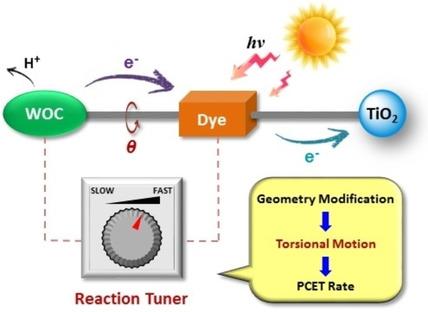当前位置:
X-MOL 学术
›
ChemSusChem
›
论文详情
Our official English website, www.x-mol.net, welcomes your
feedback! (Note: you will need to create a separate account there.)
Tuning the Proton-Coupled Electron-Transfer Rate by Ligand Modification in Catalyst-Dye Supramolecular Complexes for Photocatalytic Water Splitting.
ChemSusChem ( IF 7.5 ) Pub Date : 2020-09-01 , DOI: 10.1002/cssc.202001863 Yang 1 , Huub J M de Groot 1 , Francesco Buda 1
ChemSusChem ( IF 7.5 ) Pub Date : 2020-09-01 , DOI: 10.1002/cssc.202001863 Yang 1 , Huub J M de Groot 1 , Francesco Buda 1
Affiliation

|
In view of the considerably high activation energy barrier of the O−O bond formation photocatalytic step in water oxidation, it is essential to understand if and how nonadiabatic factors can accelerate the proton‐coupled electron transfer (PCET) rate in this process to find rational design strategies facilitating this step. Herein, constrained ab initio molecular dynamics simulations are performed to investigate this rate‐limiting step in a series of catalyst‐dye supramolecular complexes functionalized with different alkyl groups on the catalyst component. These structural modifications lead to tunable thermodynamic driving forces, PCET rates, and vibronic coupling with specific resonant torsional modes. These results reveal that such resonant coupling between electronic and nuclear motions contributes to crossing catalytic barriers in PCET reactions by enabling semiclassical coherent conversion of a reactant into a product. Our results provide insight on how to engineer efficient catalyst‐dye supramolecular complexes by functionalization with steric substituents for high‐performance dye‐sensitized photoelectrochemical cells.
中文翻译:

通过催化剂-染料超分子复合物中的配体修饰来调节质子耦合电子转移速率,用于光催化水分解。
鉴于水氧化中O−O键形成光催化步骤的活化能垒相当高,有必要了解非绝热因素是否以及如何加速该过程中的质子耦合电子转移(PCET)速率,以找到合理的方法。设计策略促进这一步骤。在此,进行约束从头分子动力学模拟,以研究催化剂组分上用不同烷基官能化的一系列催化剂染料超分子复合物中的限速步骤。这些结构修改导致可调节的热力学驱动力、PCET 速率以及与特定共振扭转模式的振动耦合。这些结果表明,电子和核运动之间的这种共振耦合通过实现反应物到产物的半经典相干转化,有助于跨越 PCET 反应中的催化势垒。我们的研究结果为如何通过空间取代基的功能化来设计高效的催化剂染料超分子复合物以用于高性能染料敏化光电化学电池提供了见解。
更新日期:2020-09-01
中文翻译:

通过催化剂-染料超分子复合物中的配体修饰来调节质子耦合电子转移速率,用于光催化水分解。
鉴于水氧化中O−O键形成光催化步骤的活化能垒相当高,有必要了解非绝热因素是否以及如何加速该过程中的质子耦合电子转移(PCET)速率,以找到合理的方法。设计策略促进这一步骤。在此,进行约束从头分子动力学模拟,以研究催化剂组分上用不同烷基官能化的一系列催化剂染料超分子复合物中的限速步骤。这些结构修改导致可调节的热力学驱动力、PCET 速率以及与特定共振扭转模式的振动耦合。这些结果表明,电子和核运动之间的这种共振耦合通过实现反应物到产物的半经典相干转化,有助于跨越 PCET 反应中的催化势垒。我们的研究结果为如何通过空间取代基的功能化来设计高效的催化剂染料超分子复合物以用于高性能染料敏化光电化学电池提供了见解。











































 京公网安备 11010802027423号
京公网安备 11010802027423号